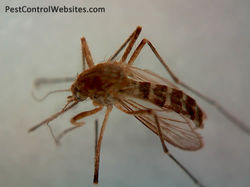 |  |  |
|---|---|---|
 |
Guide to Stinging Pests

Africanized Killer Bees
Apis Mellifera Scutellata
Description: Africanized "killer" bees looks so much like a regular honeybee that the only way to tell the two apart is by measuring their bodies. Africanized bees have different wing measurements than honeybees.
Color: Yellow/Gold with Dark Brown Bands
Legs: 6
Shape: Oval
Size: 1/2"
Antennae: True
Habits: These bees defend their colony and attack when threatened.
Habitat: Africanized bees have small colonies, so they can build nests in unique places. They have been known to live in tires, crates, boxes, and empty cars.
Threats: Their venom is no more dangerous than regular honeybees-they just tend to attack in greater numbers, which causes more danger to humans.
Prevention: Because of the aggressive nature of these pests and the enormity of their nests, a pest control professional or beekeeper must address an infestation. If you are chased by Africanized honeybees, run in a zig zag pattern and seek shelter in a house or car.

Bumble Bees
Subfamily Bombinae; Bombus Species
Description: Bumble bees are beneficial insects because they pollinate crops and plants.
Color: Black with Yellow Stripes
Legs: 6
Shape: Oval
Size: 1"
Antennae: True
Habits: The occupant of a disturbed bumble bee nest will buzz in a loud volume. They defend their nests aggressively.
Habitat: Bumble bees often nest in the ground, but can be found above ground around patio areas or decks. They will sometimes build their nests in soffit of an attics.
Threats: As part of their aggressive defense of their nests, bumble bees will chase nest invaders for a considerable distance. The bumble bee sting is one of the most painful. Unlike honey bees, bumble bees can sting more than once.
Prevention: Bumble bees can be prevented through inspection of potential nesting areas and removal of potential harborage materials. Because bumble bees will sting when threatened, homeowners are advised not to address the infestation themselves.

Honeybees
Apis Nekkufera Linnaeus
Description: Honey bees are social insects found all over the world. They are an extremely important beneficial insect because of their role in pollination. Honey bees pollinate more than 100 crops in the U.S.
Color: Yellow/Gold with Dark Brown Stripes
Legs: 6
Shape: Oval
Size: 1/2"
Antennae: True
Habits: Honeybees are active pollinators, and produce honey which feeds their young in colder months. The honeybee is the only social insect whose colony can survive many years.
Habitat: Honeybees produce honey from pollen and nectar of the plants they pollinate. They store the honey in honeycombs in their nests. They often build their nests in tree crevices, but will occasionally build nests in attics or chimneys.
Threats: Honeybees do sting, but they only sting once. The sting can be extremely painful if the stinger is not immediately removed from the sting. Persons allergic to insect stings will have a more severe reaction.
Prevention: Honeybees should be addressed by a professional. Removal of a honeybee nest and the honey product can be very messy. Because honeybee colonies are so large, only a pest control professional or experienced beekeeper can safely remove a honeybee nest.

Mosquitoes
Culex Species and others
Description: One of the best known summer pests, mosquitoes breed in stagnant water or soft soil and can develop from egg to adult in 10 to 14 days.
Color: Brown with White Stripes on Abdomen
Legs: 6
Shape: Oval
Size: 1/4" - 3/8"
Antennae: True
Habits: Female mosquitoes suck our blood. Male mosquitoes feed on plant nectars. They can develop from egg to adult in 10 to 14 days. They are most active from dusk to dawn and will fly up to 14 miles for a blood meal.
Habitat: Mosquitoes breed in stagnant water sources such as storm drains, old tires, children's wading pools and birdbaths.
Threats: Mosquitoes are well-known to spread diseases such as West Nile Virus, Zika Virus, malaria and dengue fever.
Prevention: Eliminate or reduce mosquito breeding sites by replacing all standing water at least once a week. This includes bird baths, ponds and unfiltered pools. Remove unneeded vegetation or trash from around any standing water sources that cannot be changed, dumped or removed. Introduce mosquito-eating fish such as gambusia, green sunfish, bluegills and minnows to standing water. Screen windows, doors and other openings with mesh. Avoid going outdoors when and where mosquitoes are most active: during dusk or dawn. Use insect repellent containing DEET on exposed skin whenever or wherever mosquitoes are likely to bite.

Yellowjackets
Vespula
Description: There are several species of yellowjackets. These flying insects typically have a yellow and black head/face and patterned abdomen. Many say, the pattern resembles stripes. Signature to species, the abdomen pattern can help an entomologist or pest professional identify specific types of yellowjackets.
Color: Yellow and Black Bands
Legs: 6
Shape: Lean Oval
Size: 3/8" - 5/8"
Antennae: True
Habits: Yellowjackets nest in the ground or in cavernous areas such as eaves, attics, etc. They feed on sweets and proteins and commonly invade outdoor activities.
Habitat: Yellowjackets can be found anyplace humans can be found. Check near recycling bins or other areas where sugars are common but keep in mind these pests also feed on protein. Yellowjackets become more aggressive in autumn when the colony begins to die out except for the queen.
Threats: Yellowjackets pose significant health threats to humans as they may sting repeatedly and can cause allergic reactions. Stinging insects send over 500,000 people to the emergency room each year.
Prevention: Remain vigilant and call a pest professional if you suspect yellowjacket activity. Control requires specialized equipment and safety precautions. Do not leave sweet drinks or meats in accessible areas. For example, clean up and remove food and trash after picnics and outdoor events.


